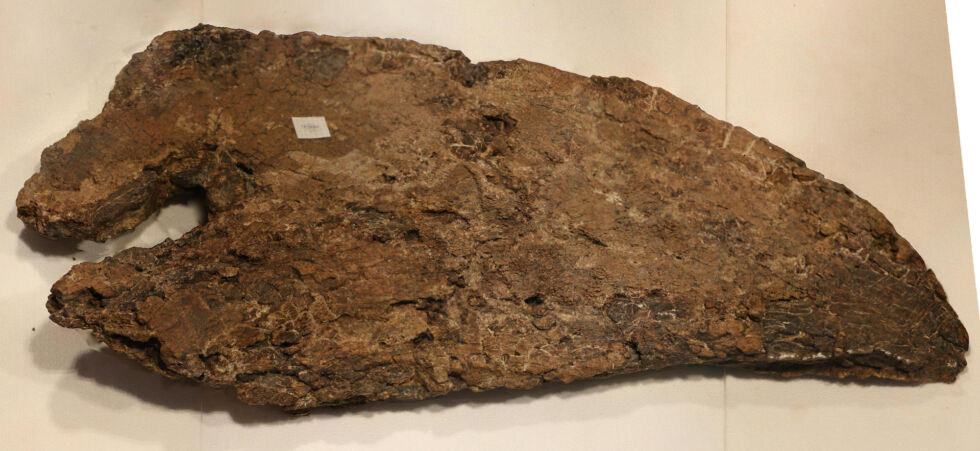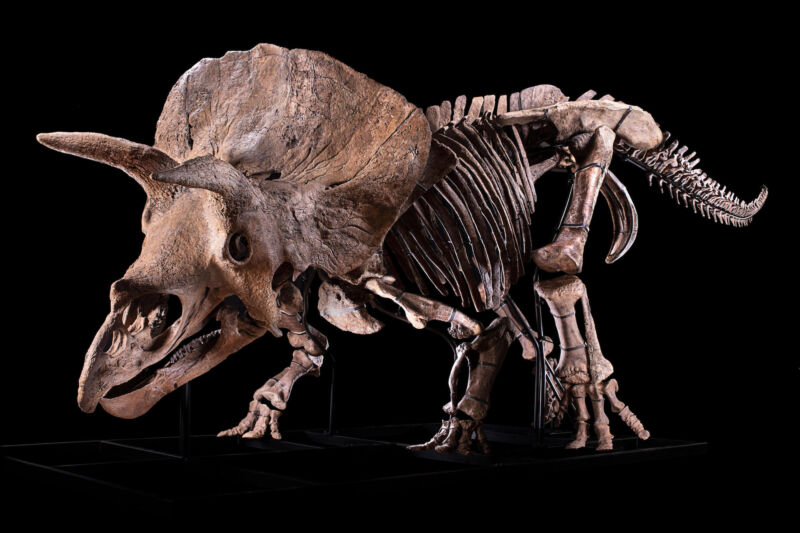It's difficult to tell which feature of the triceratops is more striking: the two large horns that jut from its forehead or the large frill that extends out from the back of its skull. In the minds of many paleontologists, the two features appear to be related. Scars found in the bones supporting the frill also seem to suggest that the animals engaged in combat with their horns, much like modern animals such as moose—fights that regularly resulted in injuries.
But it's difficult to rule out alternative explanations for some of the holes found in the fossil remains of frills. Some of the holes could have been a result of decay with age or damage after death. Now, an analysis of a triceratops skeleton known as "Big John" eliminates a couple of possibilities by showing that a hole punched through one of the bones of the frill seems to have started healing before the animal died.
Hole in one
The large frill at the back of a triceratops' head is made from large, bony plates that are fused with the bones that do the things we normally associate with skulls, like protecting the brain. They were present in early species in this lineage that lacked pronounced horns and so are thought to have originally evolved for display purposes.
In many fossils, the bones supporting the frill frequently had lesions where the bone had been damaged. Although it has been impossible to identify the source of this damage, the pronounced horns on later species have been an obvious suspect. "In the collective imagination derived from scientific and popular literature, Triceratops often faced each other in combat," the Italian authors of a new paper write. "Thus, from the second half of the twentieth century, these ceratopsids were described as pugnacious animals."

Big John has now suggested that this is more than just a figment of the popular imagination. As its name implies, Big John is a rather large triceratops skeleton, one that originated in the Hell Creek Formation in Montana. When it was being prepared for its eventual auction, the people doing the preparing noticed a rather large hole through one of the bones that supported the animal's frill. Along the largest axis, whatever made the hole had punched through nearly 20 centimeters of bone.
While it's not possible to identify precisely what did this, the people preparing the skeleton sacrificed a small piece of it to find out when in the animal's life it happened. Depending on what happened to the bone after the injury, it should be possible to eliminate a few possible reasons for this sort of bone damage.
A bit of healing
The team cut a small chunk out of the edge of the hole and shipped it to a group that specializes in analyzing the structure of old bones. Using a technique that identifies the elements that are present in the sample, they were able to show that the edges of the damaged region had a different chemical composition than the nearby undamaged bone. In addition, the structure itself was different, and there were lots of blood vessels in the area.
Overall, the researchers conclude that the bone at the edge of the damage was relatively new growth and consists of an area that was actively being remodeled. That clearly means that Big John lived for some time after receiving the injury, nicely ruling out post-mortem damage as the source of these types of injuries. The regrowth of bone also eliminates the possibility that the damage is the result of bone decay in older animals.
While eliminating two alternative explanations for the damage makes blaming it on fights more likely, it's still not possible to say that Big John had been rumbling with a fellow triceratops. But the researchers note that the damage is consistent with a horn going through the frill from behind, which could happen if the animals were moving in parallel during a fight.
Nature Communications, 2022. DOI: 10.1038/s41598-022-08033-2 (About DOIs).



3175x175(CURRENT).thumb.jpg.b05acc060982b36f5891ba728e6d953c.jpg)
Recommended Comments
There are no comments to display.
Join the conversation
You can post now and register later. If you have an account, sign in now to post with your account.
Note: Your post will require moderator approval before it will be visible.